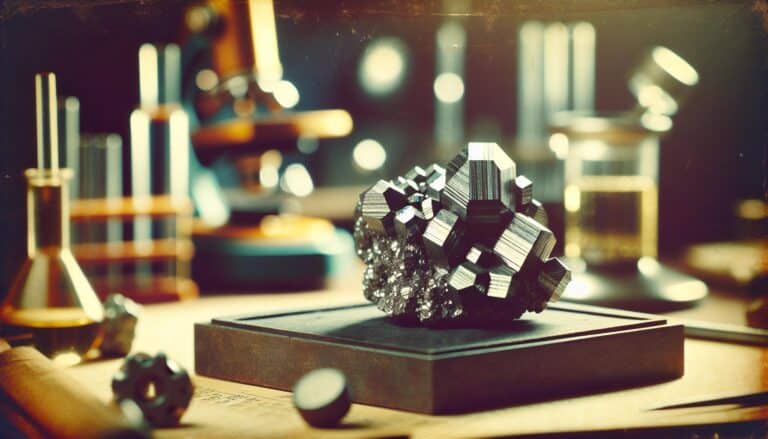Ever wondered about the value of that shimmering opal jewelry you’ve admired?
Opals are not only stunning; they’re also among the most intriguing gemstones out there. Their worth can be as varied as their iridescent colors, ranging from a few dollars to thousands per carat.
Understanding opal’s value involves more than just admiring its play-of-color. Factors like type, color, clarity, and carat weight play significant roles in determining its price.
Let’s dive into the world of opals and uncover what makes them so desirable—and what that means for their value.
Opal valuation hinges on type, color, clarity, and carat weight. Most sought-after are Black Opals for their dark body and vibrant play-of-color. Opals need careful handling due to their softness and high water content. Rarity, global trends, and collector interest also influence opal prices.
What Is Opal?
Opal stands out as a gemstone with its unique play-of-color, which you won’t find in any other gem. This distinctive feature is due to its formation through the deposition of silica gel millions of years ago. Scientifically, opal is a form of silica, closely related to quartz, though containing more water within its mineral structure.
The water trapped within the gem’s structure scatters light to create a rainbow of colors, a phenomenon known as diffraction. Each opal displays a one-of-a-kind pattern of colors like a painter’s palette, a signature making your jewelry piece exclusive.
Types of Opals
Opals are categorized into different types based on their characteristics:
- Black Opal: Boasting a dark body color, black opals are considered the most sought-after and valuable.
- White Opal: These have a lighter body, showing a play-of-color against a white or light gray backdrop.
- Boulder Opal: Found embedded within ironstone boulders, boulder opals feature thin seams of opal surrounded by rock.
- Fire Opal: Known for its warm body colors, ranging from yellow to orange and red, fire opals may not always exhibit play-of-color.
The type of opal plays a crucial role in determining its value. For example, black opals are typically more valuable than their white counterparts.
Care and Durability
Due to their high water content, opals can crack or “craze” if allowed to dry out. It’s essential to understand that opal care differs from other gemstones. Avoiding extreme temperature changes and harsh chemicals can prolong your opal’s life.
With a hardness rating of 5.5 to 6 on the Mohs scale, opals are softer than many other gemstones. Your opal jewelry needs to be worn and stored with care to prevent scratches. When properly cared for, opals retain their mesmerizing beauty for generations, making them a treasured addition to your collection.
Opal Prices: Factors That Affect Value

Understanding how much your opal is worth requires a look into several key factors that influence its market value. These factors help determine the price point for each individual gemstone, making the evaluation as unique as the opal itself.
Color, Clarity, and Cut Quality
The interplay of colors within an opal, referred to as its ‘play-of-color’, is one of the most significant factors that affect its value. Vivid and bright flashes across the color spectrum tend to increase the opal’s worth, especially if red hues are dominant. Here’s a quick run-down:
- Brightness: The brighter the colors in the opal, the higher its value.
- Pattern: A large, bold pattern is more desirable and valuable than a small or subdued pattern.
- Range of Color: Opals showing a full spectrum of color usually fetch higher prices.
- The clarity of an opal can either enhance or detract from its overall appearance and value. Opals free from inclusions or cloudiness are more sought after and command greater prices.
When it comes to cut, a well-executed cut can maximize an opal’s play-of-color and overall visual appeal. Non-standard cuts may be used to highlight the unique beauty of each stone, but a poorly cut opal could reduce its desirability. Cut quality does not just affect aesthetics; it can also ensure the durability of the gemstone.
Market Demand and Availability
Market demand for opals largely influences their value, fluctuating with changing trends and consumer preferences. Rarity plays a key role here; for instance, the rare black opal is often more expensive due to its scarcity.
Another factor is the availability of opals in certain markets; certain regions may value opals differently based on local tastes and the availability of the gemstone. Here’s what you need to know:
- Rare Finds: Unique opals with striking patterns or particularly vibrant play-of-color can have increased demand, driving up prices.
- Source Locale: Opals from traditional sources like Australia might command higher prices due to the established market for high-quality stones from these areas.
- Global Trends: Changing fashion trends can lead to spikes in demand for certain types or colors of opal.
- Collector Interest: Opals with unique characteristics may be especially valuable to collectors, which can increase their overall market value.
When considering an opal’s value, it’s crucial to weigh these factors. The unique characteristics of each stone interact with global market conditions to determine how much an opal is worth. Assessing opal prices is about understanding the delicate balance between intrinsic qualities and extrinsic market forces.
Understanding Opal: A Rare Gem

When you’re gauging the value of opals, it’s vital to grasp why they’re not just another stone. Opal’s allure stems from its rarity and the unique conditions required for its formation.
The Rarity of Opal
Opals are scarce gems that differ significantly from their mineral counterparts. They form over millions of years from a solution of silicon dioxide and water. As water runs down through the earth, it picks up silica from sandstone, and this silica-rich solution finds its way into cracks and voids. When the water evaporates, it leaves behind a silica deposit that gradually hardens into opal.
Key factors contributing to the rarity of opals include:
- An extended formation period
- Specific environmental conditions
- Limited geographical availability
Australia, which produces over 90% of the world’s opals, harnesses some of the most fertile grounds for this intricate process. Even within such prime regions, finding opal is a matter of luck and persistence, with many areas extensively mined with only a few yielding high-quality stones.
Origins and Characteristics
Opals originate from various regions, each imparting distinct traits that affect their desirability and value. Australian opals are highly prized, particularly the Black Opal from Lightning Ridge and the White Opal from South Australia. However, other sources including Mexico, Brazil, and Ethiopia also contribute to the opal market, with Ethiopian Welo Opals gaining recognition for their remarkable patterns and play-of-color.
Opals boast diverse characteristics that make each stone unique:
- Color: Ranges from milky white to black, with vibrant greens, blues, and reds in between.
- Pattern: Refers to the arrangement of play-of-color, with sought-after patterns like Harlequin commanding higher prices.
- Transparency: Varies from opaque to translucent, influencing the overall brilliance and depth of color.
Each opal’s intrinsic properties are a fingerprint of its origins and evolution, contributing to its individuality and worth. As such, the backstory of an opal—a record of its journey from the depths of the earth to the surface—is as fascinating as the gem itself. These aspects together shape an opal’s identity, making up the narrative that endears it to collectors and enthusiasts around the globe.
Opal Grading and Valuation
The Grading System for Opal
When you’re trying to gauge how much your opal is worth, understanding the grading system for these gemstones is crucial. Just like diamonds, opals are subject to an assessment based on a set of standardized criteria. These include:
- Brightness: How much the colors shine and sparkle under light.
- Color: The type and play of color within the opal, with red being typically the most valuable.
- Pattern: Unique formations of color patches, streaks, or flashes that make each stone distinct.
- Body tone: The range from black through dark to light which acts as the backdrop for the play of color.
- Transparency: How transparent the stone is, with crystal opals being very desirable.
- Size: Generally, the larger the opal, the higher the value.
These factors are often combined into a comprehensive score that relates directly to the opal’s market value. A higher grade means a rarer and potentially more expensive opal.
Certification and Appraisal
To solidify the value of your opal, getting it certified and appraised by a reputable authority is a smart move. This process involves:
- Certification: A certificate from a respected gemological laboratory provides an unbiased verdict on the opal’s quality. This report will highlight your opal’s unique characteristics and authenticate its grade.
- Appraisal: This step goes beyond certification and assigns a monetary value to the opal. An appraiser takes into account the current market trends, the rarity of the specific type of opal you have, as well as its overall appeal to potential buyers.
Remember, documentation from certification and appraisal can significantly increase an opal’s resale value and buyer confidence. Whether you’re insuring your gemstone or considering a sale, these formal assessments are invaluable.
Now that you know more about opal grading and valuation, you’re better equipped to understand what to look for when you’re in the market for these radiant gemstones or trying to determine the value of one you own. Keep in mind that each opal is unique, and its value extends beyond the sum of its assessable qualities to include its emotional and historical significance.
Current Market Trends in Opal Pricing
When exploring opal pricing, it’s essential to stay on top of current market trends. In recent years, there has been an increasing demand for these gemstones, particularly for high-quality specimens. The rarity of top-tier opals, combined with high demand, constantly influences their market value.
Opal prices have surged especially for black opals which are among the rarest. Lightning Ridge, a significant source of black opals, has seen its supply diminish, causing prices to soar. This supply squeeze makes black opals not only rare but also highly sought after by collectors and investors.
On the other hand, Ethiopian opals have flooded the market, impacting the price of lower-grade opals. While these opals offer stunning colors and patterns, the abundance of supply means they’re more affordable. However, an Ethiopian opal with exceptional brightness and impressive patterns can still fetch a high price.
The advent of online sales has also made opal pricing more competitive. With more sellers offering opals online, buyers have a plethora of options leading to more competitive pricing. The table below showcases the fluctuations in the average price per carat for different types of opals over the past year:
| Type of Opal | Average Price Per Carat (Previous Year) | Average Price Per Carat (Current Year) |
|---|---|---|
| Black Opal | $1,200 | $1,500 |
| Boulder Opal | $300 | $350 |
| Ethiopian Opal | $50 | $60 |
| Fire Opal | $100 | $120 |
Caring for opals is as important as understanding their market value. Opals are delicate gemstones, and proper care can preserve their luster and prevent damage. It’s important to avoid harsh chemicals and drastic temperature changes, as they can cause opals to crack or lose their play-of-color.
Remember, the true worth of an opal goes beyond the market price—it’s also about the joy and beauty it brings to your life. Whether you’re an investor or a gemstone enthusiast, keeping an eye on market trends will guide you in making informed decisions.
The Most Expensive Opal
When delving into the realm of valuable gemstones, the opal bears a uniqueness that can command staggering prices. The record-holder for the most expensive opal ever sold is the aptly named Virgin Rainbow. This illustrious stone is a black opal, famed for its intense color play and rarity, and it fetched over $1 million.
But why did it garner such a high price? The Virgin Rainbow’s value lies in its astonishing play-of-color, where every hue of the spectrum is represented in a mesmerizing dance of light. Additionally, its origin from the renowned opal-producing region of Coober Pedy in Australia adds a layer of prestige.
- Color and pattern
- Brightness and clarity
- Size and weight
- Country of origin
Black opals stand at the pinnacle of opal value, with red being the most sought-after color due to its rarity. Premium black opals can fetch thousands of dollars per carat, with prices escalating for larger stones boasting vivid colors. The desirability of these factors creates a marketplace where opals such as the Virgin Rainbow become the crown jewels, reserved for the highest echelon of collectors.
Interestingly, while the Virgin Rainbow holds the title, there are other notable contenders like the Aurora Australis, which was valued at $763,000 back in 2005 due to its extraordinary size and brilliance.
Market fluctuations and the allure of new finds can shift the rankings, but the exclusivity of top-tier opals remains uncontested. Collectors and investors alike should stay attuned to these market dynamics to grasp the full potential of these captivating gemstones’ worth.
Buying Opal: Tips and Recommendations
Navigating the opal market can feel overwhelming, but with the right guidance, you’ll find purchasing these gems both enjoyable and rewarding. Whether you’re a seasoned collector or a newcomer, understanding where to buy high-quality opal and how to verify its authenticity will ensure you make a savvy investment.
Where to Purchase High-Quality Opal
Finding a trustworthy source is crucial when you’re looking to buy high-quality opal. You can start your search at reputable jewelry stores that specialize in gemstones. Often, these establishments provide expert knowledge alongside a certification of authenticity for their stones. Local gem fairs are also a splendid venue for procuring opals as they offer the chance to compare different stones and sellers in one place.
However, as digital platforms become increasingly prevalent, you might prefer the convenience of online shopping. Here are a few pointers for buying opals online:
- Look for established retailers with a track record of positive reviews.
- Ensure they provide high-resolution images or videos to get a good look at the opal’s play-of-color.
- Confirm that they have a transparent return policy, just in case the opal doesn’t meet your expectations upon arrival.
Ensuring Authenticity and Value
The value of an opal is largely determined by its color, pattern, brightness, and size. However, its worth can only be fully appreciated if the gem is authentic. To ensure the opal you’re considering is genuine, you should:
- Request a certificate of authenticity from a recognized gemological laboratory.
- Verify the stone’s natural origin, as synthetic or treated opals are less valuable than natural ones.
- Consult with an independent valuer who can provide a non-biased assessment of the opal’s value.
Remember, high-quality opals should display a vibrant play-of-color that is evenly distributed across the gem. The body tone should be taken into account as well: the darker the body, typically the more valuable the opal, with black opals being highly coveted.
When it comes to opal buying, patience is key. Don’t rush your purchase; take your time to research sellers and verify the quality and authenticity of the gemstones on offer. With these recommendations, you’re well on your way to adding a mesmerizing opal to your collection that boasts both beauty and value.
Conclusion: Buying & Selling Opal
Remember, the worth of an opal is as unique as the gemstone itself.
Your quest to find the perfect opal is as much about personal preference as it is about its intrinsic value. Armed with the knowledge of opal grading and valuation, you’re now equipped to make an informed decision. Trust your instincts, rely on reputable sources, and don’t hesitate to seek professional advice. The true worth of an opal isn’t just in its price tag—it’s in the joy and beauty it brings to your life.
So go ahead, find that opal that speaks to you, and cherish it for a lifetime.



![Idaho Rockhounding Sites in [year]: Top Spots & Treasures](https://observationhobbies.com/wp-content/uploads/2024/01/1nS3_lIxMswz4degrvb9n-768x439.jpg)

![West Virginia Rockhounding Sites in [year]](https://observationhobbies.com/wp-content/uploads/2024/01/761QOgtzpwvHOJxQkXwdF-768x439.jpg)
![Nebraska Rockhounding Sites in [year]: Locations & Treasures](https://observationhobbies.com/wp-content/uploads/2024/01/lMVu7TzpaadhkVIDr6l3R-768x439.jpg)
